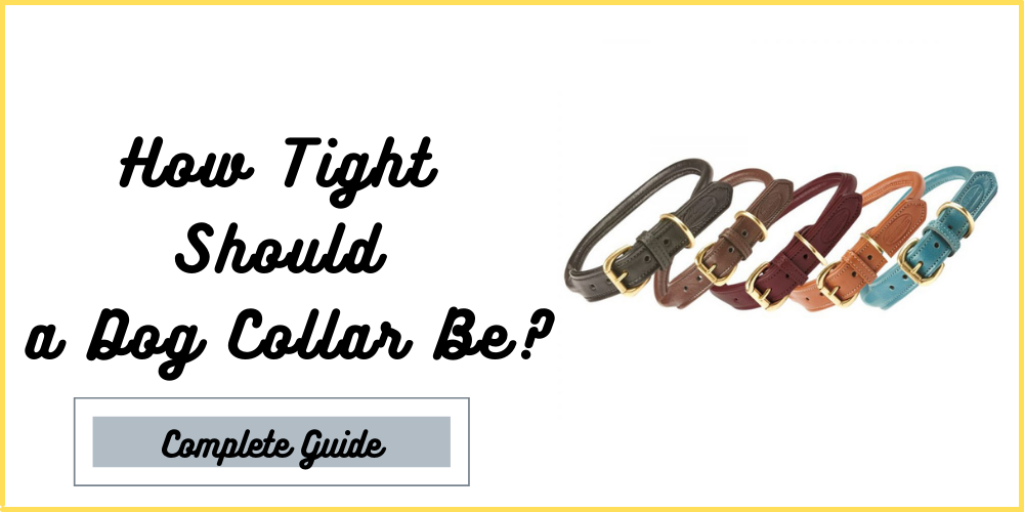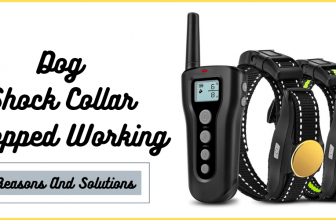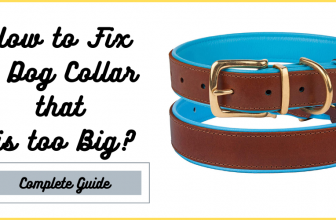Among the most important accessories for any dog are the collars. There is a great variety of collars according to the material used for their manufacture or their functions. Thus, there are leather, nylon, or metal link collars. There are also electronic collars or shock collars that allow modifying a dog’s behavior.
If you know the 2-finger rule, putting the collar on your dog can be very easy. But if you don’t know this rule, it can cause different mild or serious problems for your dog.
That is why below you can find all the information you need to correctly fit your pet’s collar. Any walk or training will be much more relaxed and easier with the right information.
Contents
How Tight Should a Dog Collar Be? – Ultimate Guide
No matter what type of collar your dog has, this accessory must be tightened in a correct way to avoid possible inconveniences that may occur. One of the main aspects to consider in a properly fitted collar is the circumference of your dog’s neck. Naturally, dogs of different sizes have different neck circumferences.
The key point here is that the collar is not too loose or too tight. It is possible to measure the circumference of the dog’s neck with a variety of tools. One of the most recommended ways to measure your dog’s neck circumference is to use a flexible tape measure. The circumference of the dog’s neck can be measured in inches or centimetres.
There is a very basic rule known as the 2-finger rule. This means that the user must calculate 2 fingers between the tape measure and the dog’s neck. In fact, this is a certain amount of extra space that is very important for the well-being of any dog. Of course, it should not be exactly 2 fingers that make up this additional space.
People can incorporate the number of extra inches or centimetres they deem necessary for each dog’s well-being. Thus, larger dogs may need a little more than 2 fingers. Smaller dogs may require less than 2 fingers to prevent the collar from becoming too loose.
Important factors in getting the collar to fit properly also include the type of coat of each dog. Some dogs have a very thick and long coat, which is an important factor to consider. The same is true for short-haired dogs. Even the coat of some dog breeds can vary too much while a year.
This variation in the coat of the same dog throughout the year considerably modifies the circumference of the neck. All these factors allow to correctly fit a dog collar, avoiding different potential dangers. These dangers are often present with a collar that is too loose or too tight.
Also Read: Do You Keep a Dog Collar on all the Time?
How Do I Know if my Dogs’ Collar is Too Tight?
As we have mentioned above, the basic and most frequent rule for correctly putting a collar on a dog is the 2-finger rule. Any collar is correctly placed on a dog when the owner can insert 2 fingers between the collar and the collar itself. This is an additional space that provides the comfort that every dog needs.
This rule may vary depending on whether it is a large breed dog or a dog that is too small. The important thing, in this case, is that there is some extra space to prevent the dogs from feeling uncomfortable at any time. If a collar is too tight against the dog’s neck, you will be more likely to notice some of the following behaviors.
A collar that is too tight on a dog can produce too much discomfort. This happens when the dog owner could not easily insert his fingers between the collar and the dog’s neck. In these situations, you can notice that the dogs will make all kinds of movements to remove the collar that is too tight.
It can also happen that the collar is a little loose. Dogs will also try to remove a loose collar that is hanging around their necks. In any of these situations, dogs are always uncomfortable, although this is even more serious when the collar is too tight.
The 2-finger rule is also a reference that does not always apply the same for dogs of different breeds. Any dog can feel uncomfortable beyond the collar being correctly adjusted. So, you could put the collar on your dog correctly and notice inappropriate behavior from your pet as well.
What Happens if a Collar is Too Tight on a Dog?
Using a collar on dogs is always important, especially when it’s time for a walk or outdoor training. However, some people may make mistakes by putting too tight a collar on their dogs. This is where some minor or serious problems can occur and should be considered.
- Hanging
Hanging is one of the most common problems when the collar is too tight. This can lead to choking or choking which can be serious depending on how tight the collar is. In turn, this can be even more serious in those dogs that pull when walking and seeing other animals or people.
In the most severe cases, a dog could suffer from choking or suffocation due to airway closure. A collar that is too tight can be more than enough to affect the dog’s respiratory system. When this is done too often, damage to the dogs’ respiratory system can become permanent at times.
- Irritated skin
Another of the most common problems that tend to happen to dogs with collars that are too tight is damage to the skin and fur near the neck. Any collar causes chafing to the skin and hair of dogs regardless of the type of material it is made of. Occasionally, some collars can cause more irritation than others, as is the case with metal collars.
Some people also leave the collar on their dogs all day long, which aggravates the problem of irritation and hair loss near the neck. That is why the collar should not be too tight on dogs. At the same time, dogs that may have sensitive skin should wear leather collars when going for walks or outdoor activities.
- Muscle injuries
Last but not least, muscle injuries in the neck area are another of the most common problems caused by tight collars. These injuries can also extend to the trachea area. Many dogs try to relieve the tension caused by a tight collar by making head movements.
So, if your dog is making sudden movements, it means that he may suffer injuries to the trachea or the muscles in the neck area. If this problem has occurred in any dog, the best is to avoid using a collar for a few days.
Also Read: Are Dog Choke Collars illegal?
How Many Fingers Should Fit Under a Dog’s Collar?
The basic and most general rule about the use of collars on dogs is the 2-finger rule. Of course, this is a guideline rule to add some extra space to the use of a collar. The dog owner should be able to fit 2 fingers between the collar and neck of each dog.
It is also possible to add some additional space by incorporating centimeters or inches to the circumference of a dog’s neck. The 2-finger rule is a basic rule that should be adapted to the characteristics of each dog.
Large dogs may need more than 2 fingers of additional space to feel truly comfortable, without any hanging sensation. Smaller dogs may require only one finger of additional space.
In either case, the most important thing is always to avoid having a collar that is tight enough to cause choking or other problems. It is also necessary to avoid making the collar too loose, as the collar then becomes both a useless and dangerous accessory.
Many users often use a dog collar to add an identification tag with the owner’s data. Therefore, it is important to adapt the 2-finger rule to the characteristics of each dog. When dogs feel discomfort from a collar that is too tight and poorly fitted, they will do everything possible to remove the collar.
How Do I Know if My Collar is Too Loose?
A dog owner should not only check if his pet’s collar is too tight. It is also crucial to check if the collar is not too loose, which can also be dangerous. Whether your dog wears a collar at night or during the day, this accessory should not be too loose to avoid the following problems.
- Dog Escape
Any collar is usually used on most occasions when it is time for dog walking. At the same time, many walks take place in cities with people, other animals, or vehicles driving through the streets. So, if the collar your dog is wearing is too loose, your pet could run away.
When a dog’s collar is too loose, they may try to remove it quickly. So, this can result in a dangerous situation for other people or for your dog itself. Even if your dog is overly anxious and pulls on the leash, it is always advisable to adjust the collar properly.
- Paw or mouth injuries
Another of the most common problems that a too-loose collar can cause is caused by your dog’s own movements. As we have mentioned, many dogs will try to remove a collar when it is too loose. This is where your dog’s mouth or paws can get caught, which can be very painful and uncomfortable for your dog.
- Skin irritation
Another classic problem caused by many dog collars is skin irritation or hair loss. The friction of the collar against the dog’s hair and skin also occurs when the collar is too loose.
If you want to prevent your pet from feeling great discomfort for several days, the collar should be properly adjusted. This is enough to reduce the rubbing of the collar against your dog’s skin and hair.
How Should an E-Collar Fit on a Dog?
Unlike ordinary dog collars, an e-collar incorporates different functions to modify your pet’s behaviour. This includes shock collars or collars that serve to monitor your dog’s location via GPS. Regardless of the type of collar, the 2-finger rule is also present in this case.
Here is the basic rule of adding 2 fingers of extra space between your dog’s neck and the e-collar. This way you add the appropriate additional space so that this accessory is properly fitted. The 2-finger rule is designed to prevent hanging from a collar that is too tight, which causes other problems.
This same extra space rule also prevents the E-Collar from becoming too loose. In fact, the e-collar is incorporated into dogs that are free to move over a large area. A collar that is too loose could get lost anywhere, preventing the dog owner from being able to continue to monitor and care for their pet.
An e-collar that is too loose could also get a dog stuck on a branch, a metal fence, or any other dangerous object. So, the 2-finger rule should be applied according to the characteristics of each dog. Larger dogs may need some additional space that exceeds the additional space added by 2 fingers.
Smaller dogs usually do not need as much additional space as 2 fingers. However, e-collars have other features that should be considered in the fit on your dog’s neck. One example is shock collars that incorporate contact points to deliver the shock.
Each of these contact points must be touching the dogs’ skin to produce the desired effect. So, the collar must be a little tighter when it is a shock collar. Beyond that, it is always much more important to avoid the choking or drowning that any dog can suffer from a collar that is too tight.
Conclusion:
When putting a collar on your dog, you should be able to fit 2 fingers between your dog’s neck and the collar. This is the 2-finger rule and adds extra space between the collar and your dog’s neck.
Without a doubt, this is one of the most important rules in the use of any collar. This avoids the minor or major problems of a collar that is too tight or too loose.








